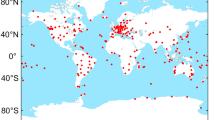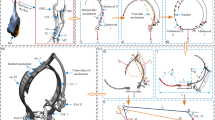Abstract
This study considers intermittent maneuver based on line-of-sight rate bounding to improve target observability for passive homing guidance. Target observability is critical for the performance of the target tracking filter and indirectly affects the guidance accuracy. This paper derives an observability measure associated with the Fisher information matrix for the adaptive intermittent maneuver strategy proposed in the previous studies. Then, the key parameters of the adaptive intermittent strategy are identified and optimized to maximize the observability measure. Numerical simulations demonstrate that the tracking filter performance is significantly improved. It is also confirmed that the guidance accuracy of proportional navigation is also improved by employing the adaptive intermittent maneuver strategy.











Similar content being viewed by others
References
Palumbo NF, Blauwkamp RA, Lloyd JM (2010) Basic principles of homing guidance. Johns Hopkins APL Technical Digest 29(1):25–41
Waldmann J (2002) Line-of-sight rate estimation and linearizing control of an imaging seeker in a tactical missile guided by proportional navigation. IEEE Trans Control Syst Technol 10(4):556–567
Kim TH, Lee CH, Jeon IS, Tahk MJ (2013) Augmented polynomial guidance with impact time and angle constraints. IEEE Trans Aerosp Electron Syst 49(4):2806–2817
Kim TH, Lee CH, Tahk MJ (2011) Time-to-go polynomial guidance laws with terminal impact angle/acceleration constraints. IFAC Proc Vol 44(1):3915–3919
Ryoo CK, Cho H, Tahk MJ (2005) Optimal guidance laws with terminal impact angle constraint. J Guid Control Dyn 28(4):724–732
Lee CH, Kim TH, Tahk MJ, Whang IH (2013) Polynomial guidance laws considering terminal impact angle and acceleration constraints. IEEE Trans Aerosp Electron Syst 49(1):74–92
Van Handel R (2009) Observability and nonlinear filtering. Probab Theory Relat Fields 145(1–2):35–74
Liu PT (1988) An optimum approach in target tracking with bearing measurements. J Optim Theory Appl 56(2):205–214
Tahk MJ, Ryu H, Song EJ (1995) Observability characteristics of angle-only measurement under proportional navigation. In: SICE'95. Proceedings of the 34th SICE Annual Conference. International Session Papers (pp. 1509–1514). IEEE.
Hepner SA, Geering HP (1990) Observability analysis for target maneuver estimation via bearing-only and bearing-rate-only measurements. J Guid Control Dyn 13(6):977–983
Nardone SC, Aidala VJ (1981) Observability criteria for bearings-only target motion analysis. IEEE Trans Aerosp Electron Syst 2:162–166
Song TL (1996) Observability of target tracking with bearings-only measurements. IEEE Trans Aerosp Electron Syst 32(4):1468–1472
Kim TH, Lee CH, Tahk MJ (2013) Time-to-go polynomial guidance with trajectory modulation for observability enhancement. IEEE Trans Aerosp Electron Syst 49(1):55–73
Song TL, Um TY (1996) Practical guidance for homing missiles with bearings-only measurements. IEEE Trans Aerosp Electron Syst 32(1):434–443
Speyer JL, Hull DG, Larson SW, Tseng CY (1984) Estimation enhancement by trajectory modulation for homing missiles. J Guid Control Dyn 7(2):167–174
Hull DG, Speyer JL, Burris DB (1990) Linear-quadratic guidance law for dual control of homing missiles. J Guid Control Dyn 13(1):137–144
Tahk MJ, Speyer JL (1989) Use of intermittent maneuvers for miss distance reduction in exoatmospheric engagements. In Guidance, Navigation and Control Conference, p. 3547.
Tahk MJ, Ryu H (1992) Adaptive intermittent maneuvers of passive homing missiles for intercept performance improvement. In: 18th Congress of ICAS. ICAS, p.1133–1137
Lee HI, Tahk MJ, Sun BC (2001) Practical dual-control guidance using adaptive intermittent maneuver strategy. J Guid Control Dyn 24(5):1009–1015
Tichavsky P, Muravchik CH, Nehorai A (1998) Posterior Cramér-Rao bounds for discrete-time nonlinear filtering. IEEE Trans Signal Process 46(5):1386–1396
Wu, W, Zhang F, Wardi Y (2014) Target localization: Energy-information trade-offs using mobile sensor networks. In: 53rd IEEE Conference on Decision and Control. IEEE, p. 2944–2949
Hammel SE, Liu PT, Hilliard EJ, Gong KF (1989) Optimal observer motion for localization with bearing measurements. Comput Math Appl 18(1–3):171–180
Song TL, Ahn JY, Park C (1988) Suboptimal filter design with pseudomeasurements for target tracking. IEEE Trans Aerosp Electron Syst 24(1):28–39
Whitcombe DW (1972) Pseudo state measurements applied to recursive nonlinear filtering (No. TR-0073 (3115)-2). Aerospace Corp, EL Segundo CA, Engineering Science Operations.
Cho MH, Tahk MJ, Kim MC, Lee D, Yoon J (2017) Modified gain pseudo-measurement filter design for radar target tracking with range rate measurement. In: 2017 25th Mediterranean Conference on Control and Automation (MED). IEEE, pp. 1195–1200
Acknowledgement
This work was conducted at High-Speed Vehicle Research Center of Korea Advanced Institute of Science and Technology with the support of Defense Acquisition Administration and Agency for Defense Development (Contract Number: UD170018CD)
Author information
Authors and Affiliations
Corresponding author
Rights and permissions
About this article
Cite this article
Lee, D., Tahk, MJ. & Lee, CH. Optimal Threshold of Intermittent Maneuver for Target Observability Improvement. Int. J. Aeronaut. Space Sci. 22, 911–922 (2021). https://doi.org/10.1007/s42405-020-00302-6
Received:
Revised:
Accepted:
Published:
Issue Date:
DOI: https://doi.org/10.1007/s42405-020-00302-6




